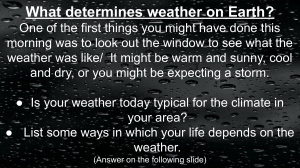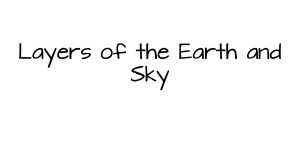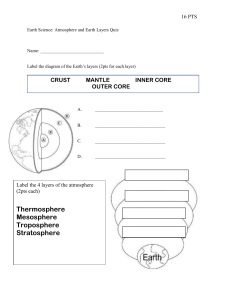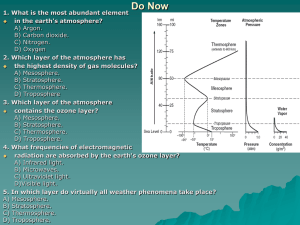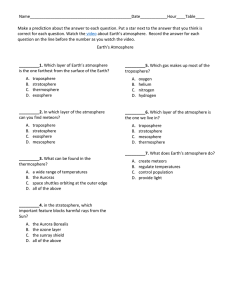Layers of the planet (earth and atmosphere layers)
advertisement
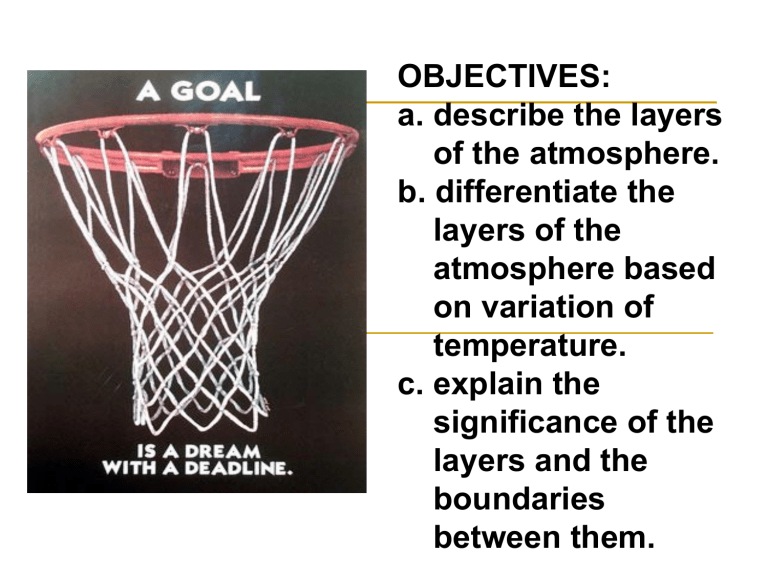
OBJECTIVES: a. describe the layers of the atmosphere. b. differentiate the layers of the atmosphere based on variation of temperature. c. explain the significance of the layers and the boundaries between them. LAYERS OF THE EARTH’S ATMOSPHERE Layers of the Earth’s Atmosphere From top to Bottom Thermosphere Mesopause Mesosphere Stratopause Stratosphere Tropopause Troposphere TROPOSPHERE • Lowest and thinnest layer — • 16 km at equator, 8 km at poles 90% of the atmosphere’s mass Temperature decreases with altitude — — — 6°C per kilometer Top of troposphere averages –50°C Where weather occurs Boundary between the troposphere, and the stratosphere is called the tropopause STRATOSPHERE Extends from 10 km to 50 km above the ground Less dense (less water vapor) Temperature increases with altitude Almost no weather occurrence Contains high level of ozone > ozone layer Upper boundary is called stratopause MESOSPHERE Extends to almost 80 km high Gases are less dense. Temperature decreases as altitude increases. Gases in this layer absorb very little UV radiation. THERMOSPHERE above the mesosphere and extends to almost 600 km high temperature increases with altitude readily absorbs solar radiation Temperature can go as high as 1,500 °C reflects radio waves EXOSPHERE the interface between Earth and space atoms and molecules can escape to space Structure of Atmosphere Stratospheric ozone is good ozone — protects Earth from harmful UV radiation — depletion is detrimental to life Tropospheric ozone is bad ozone — In the troposphere, ozone is a pollutant . • CFCs (pollutant) Ozone Depletion main cause is CFC pollution radiation from the sun causes the CFCs to break down releases one chlorine atom Chlorine atom reacts with ozone (O3 ) molecules forming chlorine oxide(ClO) and oxygen gas ( O2). Global Warming An increase in Earth’s average surface temperature caused by an increase in greenhouse gases. caused by Greenhouse Effect Greenhouse Effect the trapping of heat by gases in the atmosphere Greenhouse gases > carbon dioxide > sulfur dioxide > ozone > CFCs > water vapor Effects of Greenhouse Gas Pollution Global warming > ice in polar caps will begin to melt > water in the ocean expands > flooding in lowlands and coastal areas > changes in weather patterns Recall Identify the layers of the atmosphere based on the given descriptions. 1. the layer where weather occurs___________ 2. the coldest layer___________ 3. the ozone layer is part of this layer________ 4. the hottest layer________________ 5. the layer above the troposphere__________ I. DIRECTIONS: Match the items in column A with those in column B. Write the letter of the correct answer on your size 2. A B ____1. Troposphere A. reflects radio waves ____2. Stratosphere B. lowest layer in the atmosphere ____3. Ionosphere C. highest layer in the atmosphere ____4. Exosphere D. layer where jets fly to minimize the effects of weather. E. keeps most of the UV radiation from the sun from reaching the earth’s atmosphere. II. DIRECTIONS: Choose the correct answer from the words inside the parenthesis. 1. Compared to warm air, cold air is (more dense, less dense, about the same density) for a given volume. 2. The layer closest to the earth , where all weather changes take place is called the (stratosphere, troposphere, exosphere, ionosphere). 3. The layer after the mesosphere where air is very thin is called the (exosphere, stratosphere, thermosphere, troposphere). 4. The layer in which the temperature drops as altitude increases is called the (exosphere, thermosphere, stratosphere, troposphere). III. DIRECTIONS: Answer in not more than 5 sentences. Air pollution due to suspended particulate matter in the air -----primarily dust and smoke pose a major health problem to city dwellers. This is a concern not only in Metro Manila but all over the world, where urban cities are becoming highly industrialized. 2.. 1 What can factories do or implement to control air pollution that reaches the most affected layer of the atmosphere? 2 Write down at least one latest/recent discovery or breakthrough in utilizing other energy sources that create less air pollution The Earth is composed of Four different layers. 1. 2. 3. The crust is the layer that you live on, and it is the most widely studied and understood. The mantle is much hotter and has the ability to flow. The outer core and inner core are even hotter with pressures so great you would be squeezed into a ball smaller than a marble if you were able to go to the center of the Earth! The Crust The Earth's Crust is like the skin of an apple. It is very thin in comparison to the other three layers. Composition: made of granite and basalt State of matter: Solid rock The Crust Continental Crust: Thickness: 30-70 km Composition: Granite State of matter: solid rock Oceanic Crust: Thickness: 8 km Composition: Basalt State of matter: Solid rock The Crust: Lithosphere The crust and the upper layer of the mantle together make up a zone of rigid, brittle rock called the Lithosphere. The crust of the Earth is broken into many pieces called plates. The plates "float" on the soft, semi-rigid asthenosphere. The Mantle The Mantle is the largest layer of the Earth. It makes up the biggest part of Earth’s mass. Composition: Made of dense, iron-rich minerals (Fe, Mg, Ca, Si, & O) Temperature: 1000°C State of matter: Plastic, solid (Flows like tar) Thickness: 2900 km The Mantle: Asthenosphere •The asthenosphere is the semi-rigid part of the middle mantle that flows like hot asphalt •The movement of the middle mantle (asthenosphere) is the reason that the crustal plates of the Earth move. Convection Currents The middle mantle "flows" because of convection currents. Convection currents are caused by the very hot material at the deepest part of the mantle rising, then cooling and sinking again --repeating this cycle over and over. The Outer Core The Outer Core a hot, dense ball of liquid metals. Composition: Made of Nickel and Iron Temperature: 3700°C State of matter: Liquid Thickness: 5100 Km
